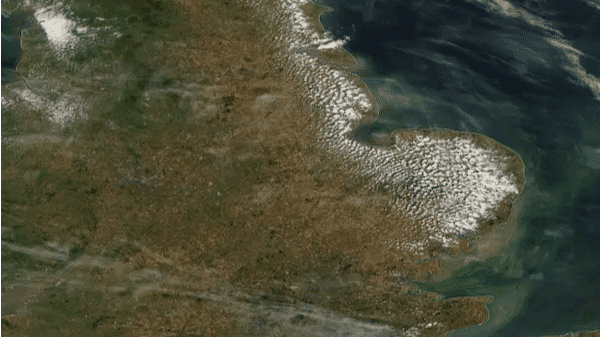The satellite images that were taken from outer space show the impact of the latest heatwave which has left the United Kingdom parched and brown compared to the largely green landscape of July 2021.
Earlier this week, Britain saw temperatures soar to record-breaking highs, surpassing the 40C mark for the first time in history.
Also read: Why baked Britain cannot beat the heat
The historic temperature of 40.3°C was recorded at Coningsby on July 19 which beat the previous record of 38.7°C set in 2019 by 1.5°C.
The heatwave prompted the Met Office to issue its first ever red warning for extreme heat. This means there was a threat to life as experts predicted thousands could die in heat-related incidents.
Scorching temperatures also saw dozens of wildfires igniting across the country, tearing through the British countryside and in some cases forcing communities to flee as the inferno spread to homes.
Also read: UK heatwave: Britain bakes after breaking 2019 high temperature record
Now the damage caused by the unprecedented temperatures has been laid bare in images from American space agency NASA which were shared online by BBC weather presenter and meteorologist Dan Holley.
The images show how Britain’s once vast green landscape has been transformed into arid terrain, scarred by this week’s heatwave.
It is reported that there were at least 28 wildfires in Britain on the hottest day of the year (July 19) with hundreds of firefighters across the country battling to keep the raging infernos under control.
Also read: Heatwave memes take over social media as UK tries to cope with the weather
Despite the best efforts of 100 firefighters, as many as 19 homes in Wennington were gutted by the fire. Some families later revealed how they ‘lost everything’ in the blaze.
Addressing the reporters, the Met Office’s Mike Kendon said, “Temperatures on July 18 were exceptional but they moved 2 to 4°C higher on July 19, making this date unprecedented in the context of long term climate records. What’s particularly notable is how much more widespread the heat was from this event than the previous two occurrences of temperatures in excess of 38°C in the UK.”
Also read: UK Heatwave: Increase in fire incidents to generate harmful ozone pollution
The heat resulted in the Met Office issuing its longest-range Amber warning ever, with a lead time of six days and a subsequent Red warning for extreme heat; the first such one to be issued.
In Europe, fires also raged forcing thousands of people to flee their homes as countries battled extreme heat. In France, wildfires blazed in southwestern Gironde region, burning roughly 47,700 acres as of July 19 forcing an estimated 34,000 people to be evacuated.
Two people were killed in Portugal, after a wildfire ripped across Murca municipality consuming roughly between 24,711 to 29,653 acres.







